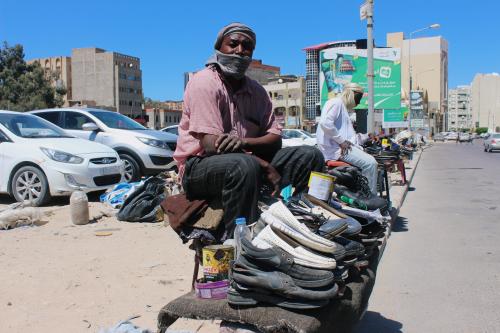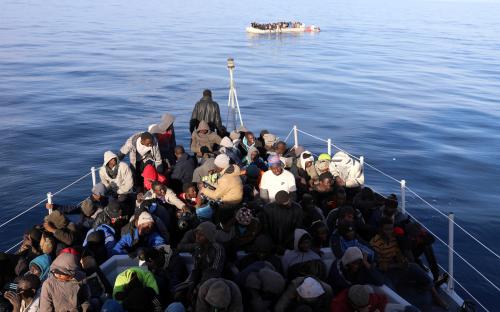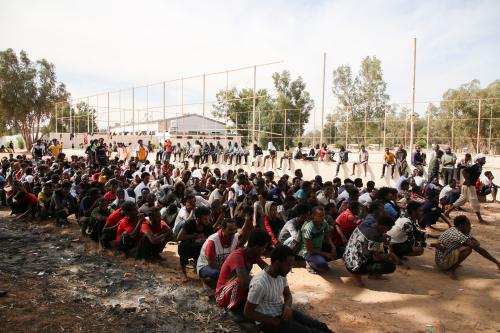In 2016, an estimated 180,000 migrants, mostly from sub-Saharan Africa, including some 26,000 unaccompanied children, made it to Italy via the sea route from Libya. One in 40, or some 4,600, died trying to cross over, 700 of them children. Actual numbers may be higher. As of mid-March 2017, there had been 481 deaths on the same route with 16,000 arrivals into Italy and 2,600 rescued from the sea; by late April, arrivals had reached nearly 37, 000, which is 12,000 more than in April 2016.
These numbers are only the more visible part of a harsh reality in Libya, a transit and a destination country for many migrants as they try to reach Europe or find work in Libya, mainly to fund their onward journey.
The International Organization for Migration (IOM) estimated in September 2016 that about 770,000 migrants and asylum seekers were in Libya. Migrants now constitute 12 percent of the country’s pre-war population. IOM estimates that 4 percent of the total migrant population are being detained, with some 7,000 held in detention facilities operated by the Tripoli government. Another 20,000 may be in detention centers controlled by traffickers, militias, and other armed groups.
According to the IOM, a litany of human tragedies is emerging out of this exodus. This includes markets where migrants are sold for ransom, forced labor, or sexual exploitation, as well as thousands of others forcibly detained, brutally mistreated, and often worked to death. A January 2017 UNHCR report on human rights in Libya notes, “Migrants in Libya are highly vulnerable, facing arbitrary detention in inhuman conditions; torture, including sexual violence; abduction for ransom; extortion; forced labor; and killings. Those held in official detention centers…under the Ministry of the Interior are held arbitrarily, with no judicial process… Armed groups, smugglers hold others in unofficial places of detention. Sub-Saharan Africans are especially vulnerable to abuse as a result of racial discrimination.”
This is the largest African migration in modern times, originating in a dozen sub-Saharan countries, funneled through Libya and heading for the 1,100-mile coastline through an often-violent border region since the demise of the Qaddafi regime. Little remains of the $500-million, 2008 European Union agreement and the $5-billion, 20-year agreement with Italy to compensate for Libya’s colonization while also safeguarding Italy from illegal migration.
While the numbers crossing over the Mediterranean are relatively well documented, there are no real numbers on those making their way into Libya across the Sahara Desert. Neither the United Nations nor other international agencies keep any data, and the few who try are underfunded. Julien Brachet at Oxford’s International Migration Institute says, “We don’t have any data… it’s a problem, because there may be as many people dying in the desert as there are in the Mediterranean… We can’t prove it, so we can’t say it, so nobody is going to intervene.”
The flow of migrants has also become an important source of revenue for various groups in Libya and beyond; including Italy’s well known organized crime groups and traffickers in South Asia with a growing number of Bangladeshis and Pakistanis among the migrants. Other beneficiaries are tribes in the border region. In March 2017, some 60 tribal leaders came to Rome to sign a peace deal to seal the border in exchange for aid and combat “an economy based on illicit trafficking.” Mohamed Haay Sandu, a tribal leader who attended the talks, stated, “For many of us, facilitating the passage of migrants has become a way of earning money. The economy is on the brink of collapse. Around 15 percent of our people work in migrant trafficking. It is the main source of income… many of our young people are without hope.” That feeling of hopelessness also underlines the threat of radical groups moving in on these routes and funds.
Over 16 months since the signing in Morocco of the U.N.-brokered Libyan Political Agreement and over a year since the U.N.-backed Presidential Council arrived in Tripoli, Libya remains divided. There are talks between the U.N.-backed Tripoli government’s Prime Minister Fayez al-Sarraj in the West and General Khalifa Haftar, representing eastern forces, with elections expected in March 2018.
In short, prospects for the nearly 1 million migrants remain grim. As Europe tries to stem this migrant flow with various deals reliant on enforcement by counterparts in Libya who have limited reach, limited capacity, and questionable human-rights credentials, the numbers of migrants and asylum seekers continues to grow. Repatriation efforts remain grossly inadequate—as of early 2017, the IOM had repatriated only 3,045 migrants since 2014.
Except for Eritreans and Somalians who have asylum acceptance rates in Italy of 84 and 97 percent respectively, rates for other African countries such as Nigeria, Gambia, Senegal, Mali, and others as well as for Bangladeshis and Pakistanis hovers around 25-30 percent—a chance most are more than willing to take—especially given the glacial pace of repatriations from Europe. Given the complications of dealing with many African countries to be convinced of easing the repatriation of their own citizens, a replication of the oft-criticized EU-Turkey agreement, largely focused on Syrian refugees, does not seem close at hand.
For now, most migrants congregate in settlements around larger cities, many trying to save for the perilous passage to Europe. Stabilization in Libya may mean more jobs in construction and services but continued strife will have its risks. For Libya, these numbers could be a tinderbox should economic conditions deteriorate further and exploitation expand while desperation among migrants worsens. This is where European funds should go—not for unworkable and inhumane holding pens and barriers in the Mediterranean—but for more development assistance to stem the flow from these countries and measures to ease the humanitarian tragedy in Libya.
The Brookings Institution is committed to quality, independence, and impact.
We are supported by a diverse array of funders. In line with our values and policies, each Brookings publication represents the sole views of its author(s).








Commentary
The tragedy of migrants in Libya
May 15, 2017